Business Finance Report: Time Value, Wealth, and Annuity Analysis
VerifiedAdded on 2021/02/18
|13
|3395
|70
Report
AI Summary
This report delves into key concepts within business finance, beginning with the time value of money and its significance in financial planning. It then examines the concept of maximizing shareholder wealth, emphasizing the importance of efficient management and positive net present value. The report differentiates between effective and nominal interest rates, illustrating their application in evaluating investment opportunities. Furthermore, it provides a detailed explanation of calculating present and future values, including the nuances of ordinary and annuity due structures. The report also includes practical examples, such as evaluating investment suitability based on present value and net present value calculations, and analyzing different annuity scenarios to determine the best investment options. The overall aim is to provide a comprehensive overview of financial principles essential for sound business decision-making.

Business finance
Paraphrase This Document
Need a fresh take? Get an instant paraphrase of this document with our AI Paraphraser
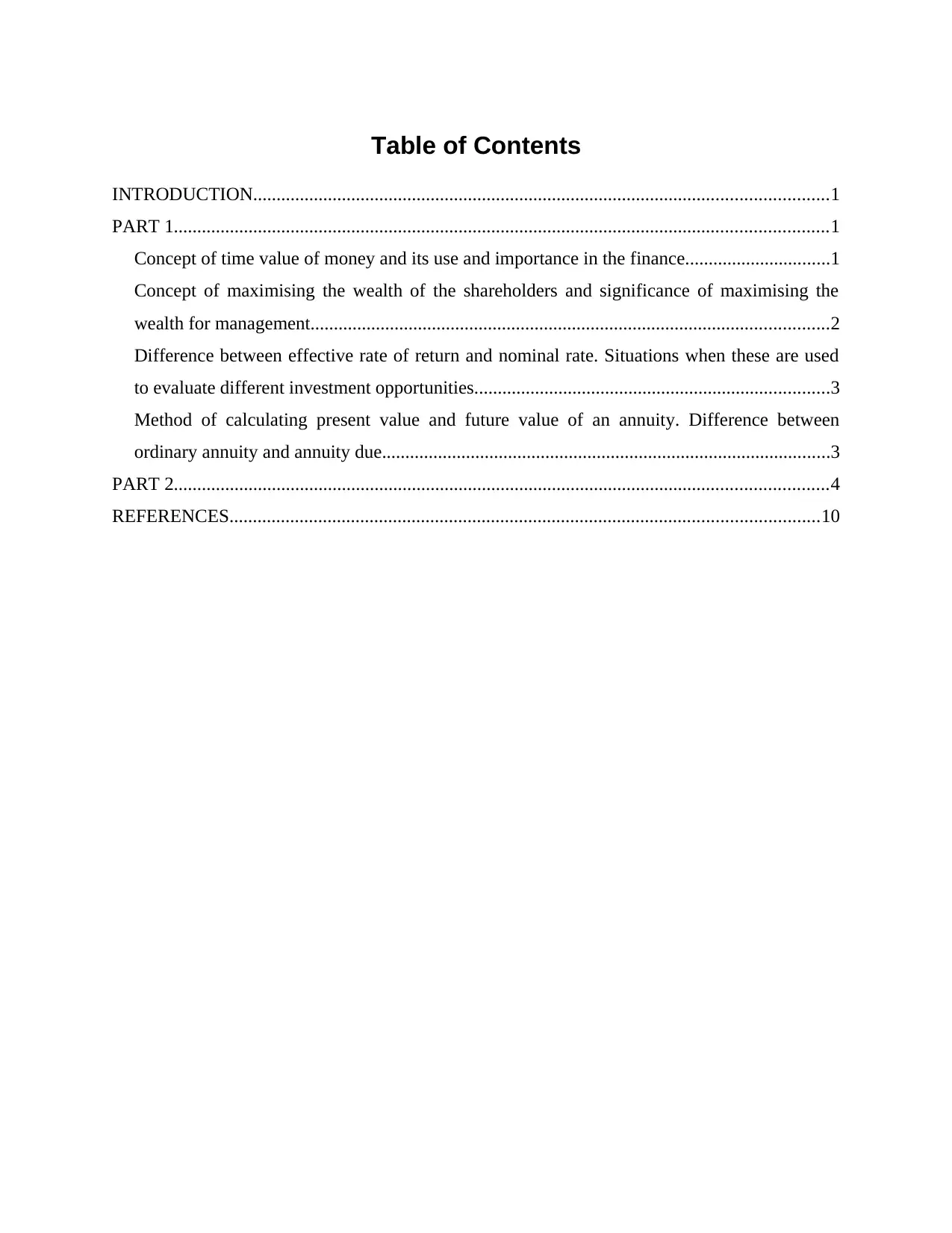
Table of Contents
INTRODUCTION...........................................................................................................................1
PART 1............................................................................................................................................1
Concept of time value of money and its use and importance in the finance...............................1
Concept of maximising the wealth of the shareholders and significance of maximising the
wealth for management...............................................................................................................2
Difference between effective rate of return and nominal rate. Situations when these are used
to evaluate different investment opportunities............................................................................3
Method of calculating present value and future value of an annuity. Difference between
ordinary annuity and annuity due................................................................................................3
PART 2............................................................................................................................................4
REFERENCES..............................................................................................................................10
INTRODUCTION...........................................................................................................................1
PART 1............................................................................................................................................1
Concept of time value of money and its use and importance in the finance...............................1
Concept of maximising the wealth of the shareholders and significance of maximising the
wealth for management...............................................................................................................2
Difference between effective rate of return and nominal rate. Situations when these are used
to evaluate different investment opportunities............................................................................3
Method of calculating present value and future value of an annuity. Difference between
ordinary annuity and annuity due................................................................................................3
PART 2............................................................................................................................................4
REFERENCES..............................................................................................................................10
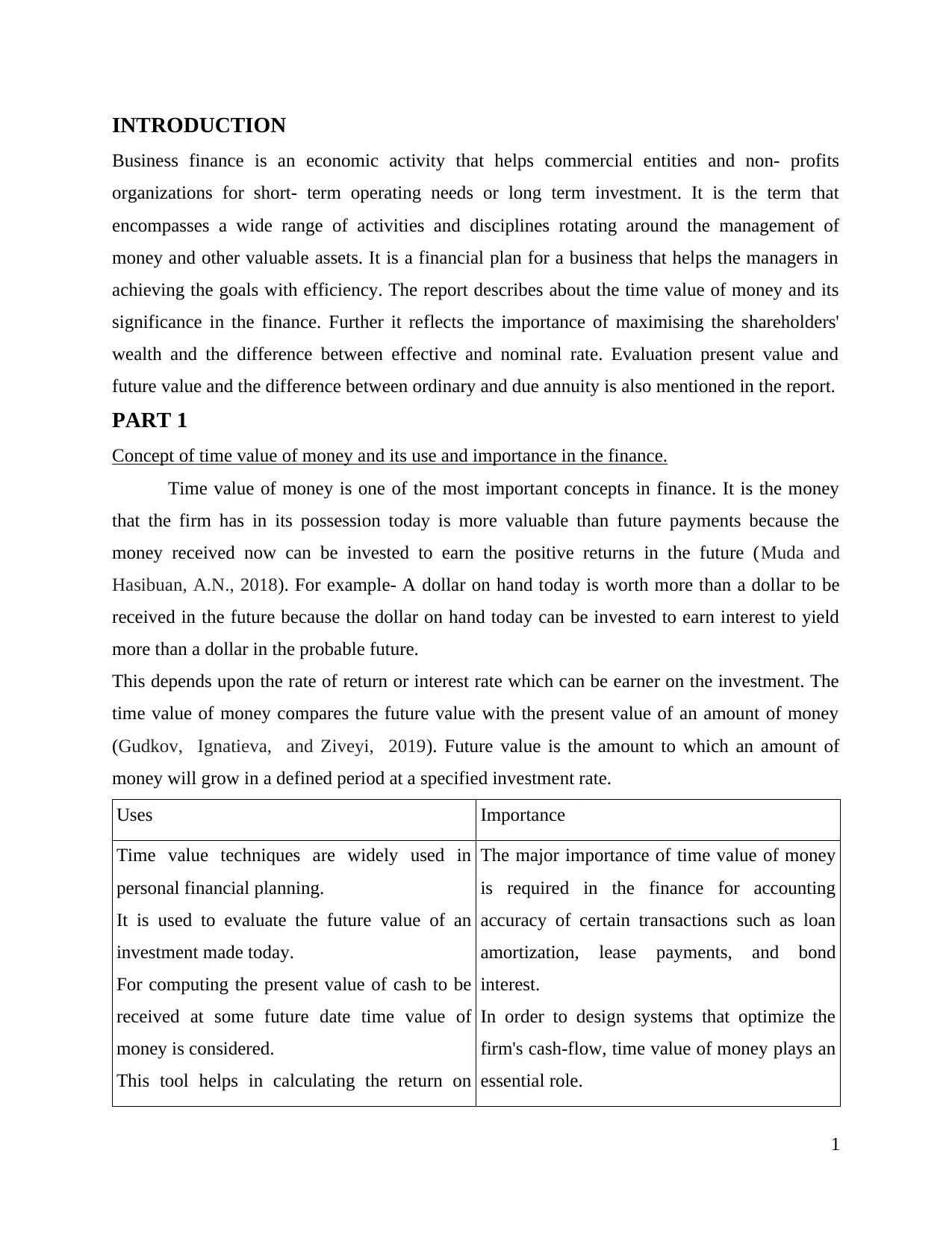
INTRODUCTION
Business finance is an economic activity that helps commercial entities and non- profits
organizations for short- term operating needs or long term investment. It is the term that
encompasses a wide range of activities and disciplines rotating around the management of
money and other valuable assets. It is a financial plan for a business that helps the managers in
achieving the goals with efficiency. The report describes about the time value of money and its
significance in the finance. Further it reflects the importance of maximising the shareholders'
wealth and the difference between effective and nominal rate. Evaluation present value and
future value and the difference between ordinary and due annuity is also mentioned in the report.
PART 1
Concept of time value of money and its use and importance in the finance.
Time value of money is one of the most important concepts in finance. It is the money
that the firm has in its possession today is more valuable than future payments because the
money received now can be invested to earn the positive returns in the future (Muda and
Hasibuan, A.N., 2018). For example- A dollar on hand today is worth more than a dollar to be
received in the future because the dollar on hand today can be invested to earn interest to yield
more than a dollar in the probable future.
This depends upon the rate of return or interest rate which can be earner on the investment. The
time value of money compares the future value with the present value of an amount of money
(Gudkov, Ignatieva, and Ziveyi, 2019). Future value is the amount to which an amount of
money will grow in a defined period at a specified investment rate.
Uses Importance
Time value techniques are widely used in
personal financial planning.
It is used to evaluate the future value of an
investment made today.
For computing the present value of cash to be
received at some future date time value of
money is considered.
This tool helps in calculating the return on
The major importance of time value of money
is required in the finance for accounting
accuracy of certain transactions such as loan
amortization, lease payments, and bond
interest.
In order to design systems that optimize the
firm's cash-flow, time value of money plays an
essential role.
1
Business finance is an economic activity that helps commercial entities and non- profits
organizations for short- term operating needs or long term investment. It is the term that
encompasses a wide range of activities and disciplines rotating around the management of
money and other valuable assets. It is a financial plan for a business that helps the managers in
achieving the goals with efficiency. The report describes about the time value of money and its
significance in the finance. Further it reflects the importance of maximising the shareholders'
wealth and the difference between effective and nominal rate. Evaluation present value and
future value and the difference between ordinary and due annuity is also mentioned in the report.
PART 1
Concept of time value of money and its use and importance in the finance.
Time value of money is one of the most important concepts in finance. It is the money
that the firm has in its possession today is more valuable than future payments because the
money received now can be invested to earn the positive returns in the future (Muda and
Hasibuan, A.N., 2018). For example- A dollar on hand today is worth more than a dollar to be
received in the future because the dollar on hand today can be invested to earn interest to yield
more than a dollar in the probable future.
This depends upon the rate of return or interest rate which can be earner on the investment. The
time value of money compares the future value with the present value of an amount of money
(Gudkov, Ignatieva, and Ziveyi, 2019). Future value is the amount to which an amount of
money will grow in a defined period at a specified investment rate.
Uses Importance
Time value techniques are widely used in
personal financial planning.
It is used to evaluate the future value of an
investment made today.
For computing the present value of cash to be
received at some future date time value of
money is considered.
This tool helps in calculating the return on
The major importance of time value of money
is required in the finance for accounting
accuracy of certain transactions such as loan
amortization, lease payments, and bond
interest.
In order to design systems that optimize the
firm's cash-flow, time value of money plays an
essential role.
1
⊘ This is a preview!⊘
Do you want full access?
Subscribe today to unlock all pages.

Trusted by 1+ million students worldwide
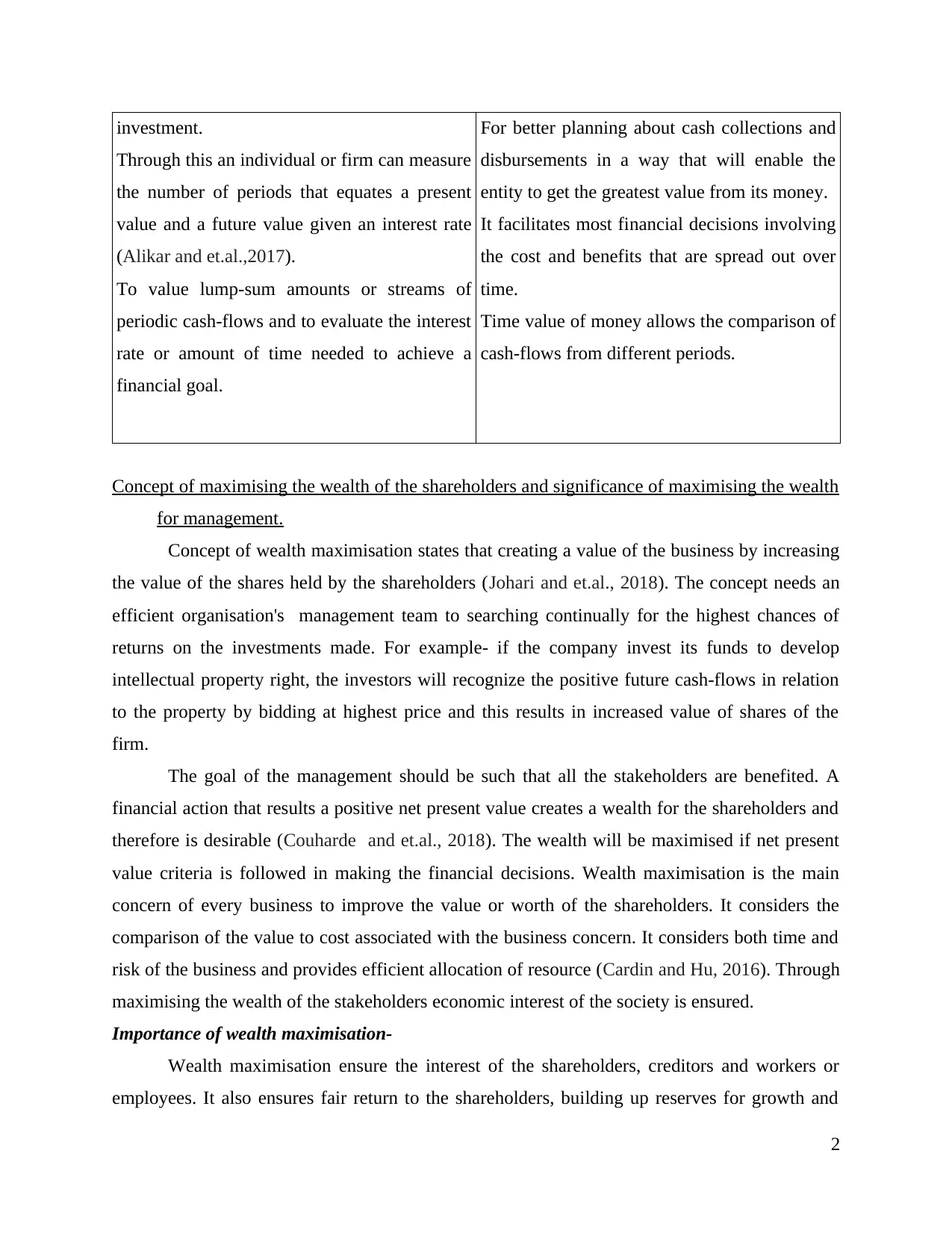
investment.
Through this an individual or firm can measure
the number of periods that equates a present
value and a future value given an interest rate
(Alikar and et.al.,2017).
To value lump-sum amounts or streams of
periodic cash-flows and to evaluate the interest
rate or amount of time needed to achieve a
financial goal.
For better planning about cash collections and
disbursements in a way that will enable the
entity to get the greatest value from its money.
It facilitates most financial decisions involving
the cost and benefits that are spread out over
time.
Time value of money allows the comparison of
cash-flows from different periods.
Concept of maximising the wealth of the shareholders and significance of maximising the wealth
for management.
Concept of wealth maximisation states that creating a value of the business by increasing
the value of the shares held by the shareholders (Johari and et.al., 2018). The concept needs an
efficient organisation's management team to searching continually for the highest chances of
returns on the investments made. For example- if the company invest its funds to develop
intellectual property right, the investors will recognize the positive future cash-flows in relation
to the property by bidding at highest price and this results in increased value of shares of the
firm.
The goal of the management should be such that all the stakeholders are benefited. A
financial action that results a positive net present value creates a wealth for the shareholders and
therefore is desirable (Couharde and et.al., 2018). The wealth will be maximised if net present
value criteria is followed in making the financial decisions. Wealth maximisation is the main
concern of every business to improve the value or worth of the shareholders. It considers the
comparison of the value to cost associated with the business concern. It considers both time and
risk of the business and provides efficient allocation of resource (Cardin and Hu, 2016). Through
maximising the wealth of the stakeholders economic interest of the society is ensured.
Importance of wealth maximisation-
Wealth maximisation ensure the interest of the shareholders, creditors and workers or
employees. It also ensures fair return to the shareholders, building up reserves for growth and
2
Through this an individual or firm can measure
the number of periods that equates a present
value and a future value given an interest rate
(Alikar and et.al.,2017).
To value lump-sum amounts or streams of
periodic cash-flows and to evaluate the interest
rate or amount of time needed to achieve a
financial goal.
For better planning about cash collections and
disbursements in a way that will enable the
entity to get the greatest value from its money.
It facilitates most financial decisions involving
the cost and benefits that are spread out over
time.
Time value of money allows the comparison of
cash-flows from different periods.
Concept of maximising the wealth of the shareholders and significance of maximising the wealth
for management.
Concept of wealth maximisation states that creating a value of the business by increasing
the value of the shares held by the shareholders (Johari and et.al., 2018). The concept needs an
efficient organisation's management team to searching continually for the highest chances of
returns on the investments made. For example- if the company invest its funds to develop
intellectual property right, the investors will recognize the positive future cash-flows in relation
to the property by bidding at highest price and this results in increased value of shares of the
firm.
The goal of the management should be such that all the stakeholders are benefited. A
financial action that results a positive net present value creates a wealth for the shareholders and
therefore is desirable (Couharde and et.al., 2018). The wealth will be maximised if net present
value criteria is followed in making the financial decisions. Wealth maximisation is the main
concern of every business to improve the value or worth of the shareholders. It considers the
comparison of the value to cost associated with the business concern. It considers both time and
risk of the business and provides efficient allocation of resource (Cardin and Hu, 2016). Through
maximising the wealth of the stakeholders economic interest of the society is ensured.
Importance of wealth maximisation-
Wealth maximisation ensure the interest of the shareholders, creditors and workers or
employees. It also ensures fair return to the shareholders, building up reserves for growth and
2
Paraphrase This Document
Need a fresh take? Get an instant paraphrase of this document with our AI Paraphraser
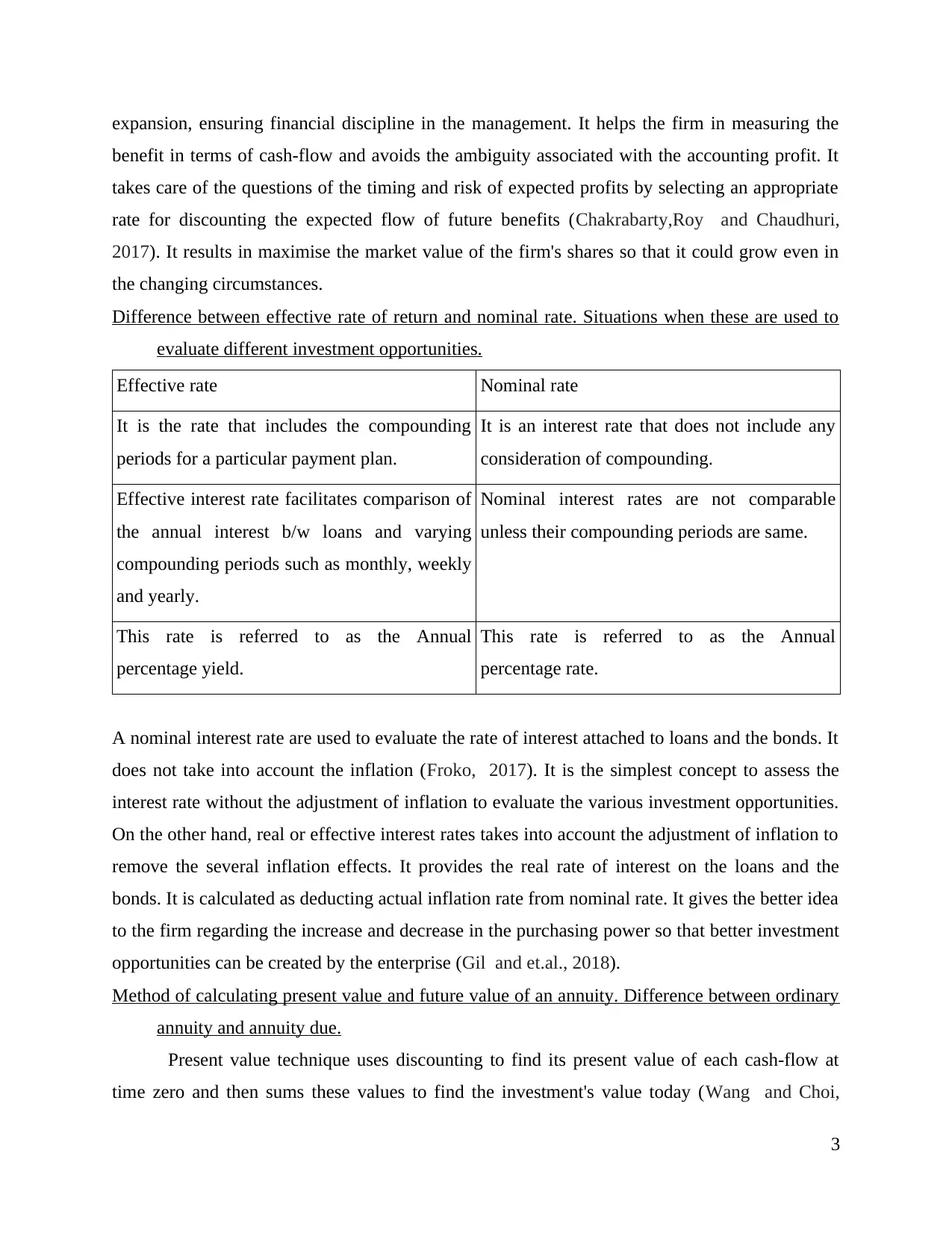
expansion, ensuring financial discipline in the management. It helps the firm in measuring the
benefit in terms of cash-flow and avoids the ambiguity associated with the accounting profit. It
takes care of the questions of the timing and risk of expected profits by selecting an appropriate
rate for discounting the expected flow of future benefits (Chakrabarty,Roy and Chaudhuri,
2017). It results in maximise the market value of the firm's shares so that it could grow even in
the changing circumstances.
Difference between effective rate of return and nominal rate. Situations when these are used to
evaluate different investment opportunities.
Effective rate Nominal rate
It is the rate that includes the compounding
periods for a particular payment plan.
It is an interest rate that does not include any
consideration of compounding.
Effective interest rate facilitates comparison of
the annual interest b/w loans and varying
compounding periods such as monthly, weekly
and yearly.
Nominal interest rates are not comparable
unless their compounding periods are same.
This rate is referred to as the Annual
percentage yield.
This rate is referred to as the Annual
percentage rate.
A nominal interest rate are used to evaluate the rate of interest attached to loans and the bonds. It
does not take into account the inflation (Froko, 2017). It is the simplest concept to assess the
interest rate without the adjustment of inflation to evaluate the various investment opportunities.
On the other hand, real or effective interest rates takes into account the adjustment of inflation to
remove the several inflation effects. It provides the real rate of interest on the loans and the
bonds. It is calculated as deducting actual inflation rate from nominal rate. It gives the better idea
to the firm regarding the increase and decrease in the purchasing power so that better investment
opportunities can be created by the enterprise (Gil and et.al., 2018).
Method of calculating present value and future value of an annuity. Difference between ordinary
annuity and annuity due.
Present value technique uses discounting to find its present value of each cash-flow at
time zero and then sums these values to find the investment's value today (Wang and Choi,
3
benefit in terms of cash-flow and avoids the ambiguity associated with the accounting profit. It
takes care of the questions of the timing and risk of expected profits by selecting an appropriate
rate for discounting the expected flow of future benefits (Chakrabarty,Roy and Chaudhuri,
2017). It results in maximise the market value of the firm's shares so that it could grow even in
the changing circumstances.
Difference between effective rate of return and nominal rate. Situations when these are used to
evaluate different investment opportunities.
Effective rate Nominal rate
It is the rate that includes the compounding
periods for a particular payment plan.
It is an interest rate that does not include any
consideration of compounding.
Effective interest rate facilitates comparison of
the annual interest b/w loans and varying
compounding periods such as monthly, weekly
and yearly.
Nominal interest rates are not comparable
unless their compounding periods are same.
This rate is referred to as the Annual
percentage yield.
This rate is referred to as the Annual
percentage rate.
A nominal interest rate are used to evaluate the rate of interest attached to loans and the bonds. It
does not take into account the inflation (Froko, 2017). It is the simplest concept to assess the
interest rate without the adjustment of inflation to evaluate the various investment opportunities.
On the other hand, real or effective interest rates takes into account the adjustment of inflation to
remove the several inflation effects. It provides the real rate of interest on the loans and the
bonds. It is calculated as deducting actual inflation rate from nominal rate. It gives the better idea
to the firm regarding the increase and decrease in the purchasing power so that better investment
opportunities can be created by the enterprise (Gil and et.al., 2018).
Method of calculating present value and future value of an annuity. Difference between ordinary
annuity and annuity due.
Present value technique uses discounting to find its present value of each cash-flow at
time zero and then sums these values to find the investment's value today (Wang and Choi,
3
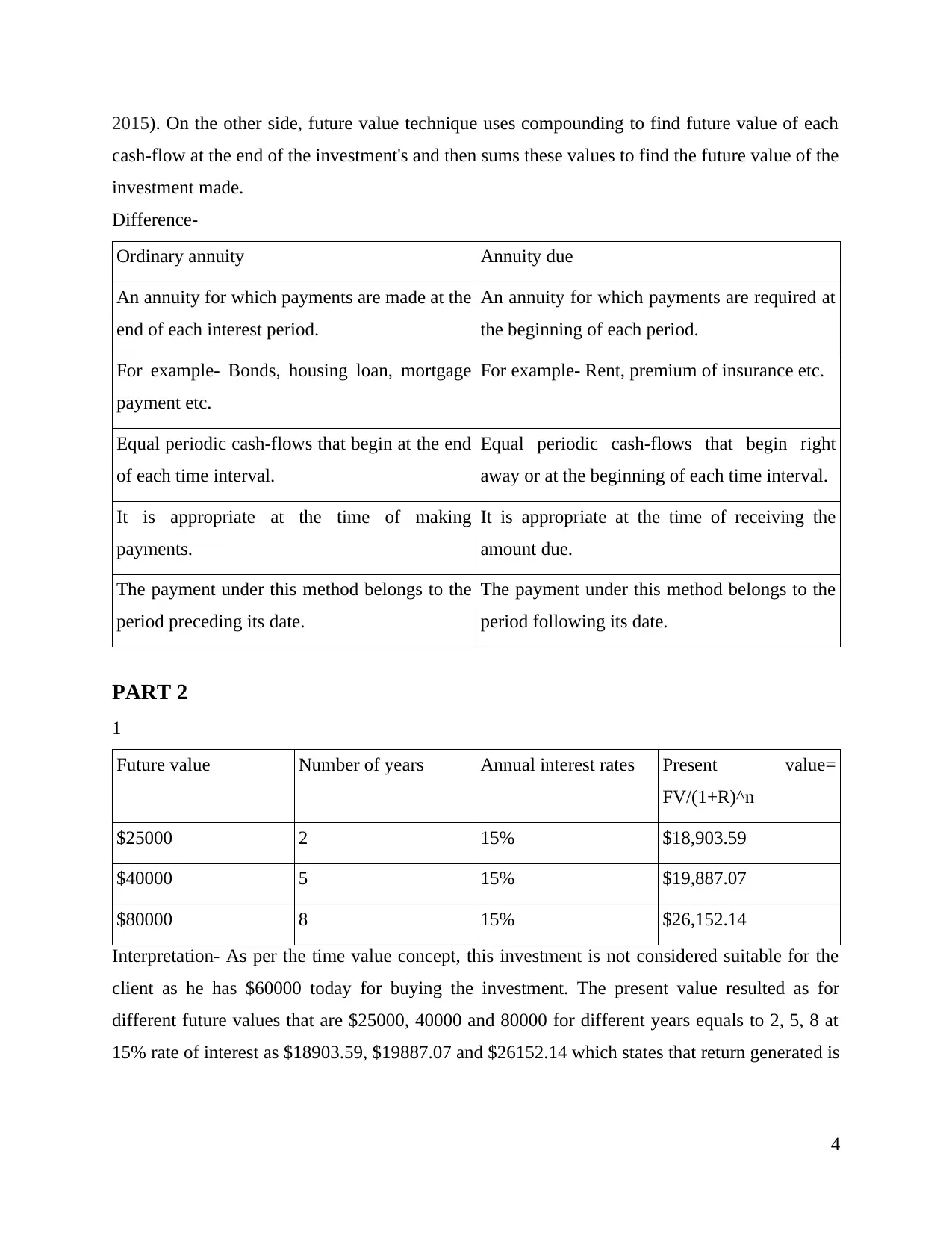
2015). On the other side, future value technique uses compounding to find future value of each
cash-flow at the end of the investment's and then sums these values to find the future value of the
investment made.
Difference-
Ordinary annuity Annuity due
An annuity for which payments are made at the
end of each interest period.
An annuity for which payments are required at
the beginning of each period.
For example- Bonds, housing loan, mortgage
payment etc.
For example- Rent, premium of insurance etc.
Equal periodic cash-flows that begin at the end
of each time interval.
Equal periodic cash-flows that begin right
away or at the beginning of each time interval.
It is appropriate at the time of making
payments.
It is appropriate at the time of receiving the
amount due.
The payment under this method belongs to the
period preceding its date.
The payment under this method belongs to the
period following its date.
PART 2
1
Future value Number of years Annual interest rates Present value=
FV/(1+R)^n
$25000 2 15% $18,903.59
$40000 5 15% $19,887.07
$80000 8 15% $26,152.14
Interpretation- As per the time value concept, this investment is not considered suitable for the
client as he has $60000 today for buying the investment. The present value resulted as for
different future values that are $25000, 40000 and 80000 for different years equals to 2, 5, 8 at
15% rate of interest as $18903.59, $19887.07 and $26152.14 which states that return generated is
4
cash-flow at the end of the investment's and then sums these values to find the future value of the
investment made.
Difference-
Ordinary annuity Annuity due
An annuity for which payments are made at the
end of each interest period.
An annuity for which payments are required at
the beginning of each period.
For example- Bonds, housing loan, mortgage
payment etc.
For example- Rent, premium of insurance etc.
Equal periodic cash-flows that begin at the end
of each time interval.
Equal periodic cash-flows that begin right
away or at the beginning of each time interval.
It is appropriate at the time of making
payments.
It is appropriate at the time of receiving the
amount due.
The payment under this method belongs to the
period preceding its date.
The payment under this method belongs to the
period following its date.
PART 2
1
Future value Number of years Annual interest rates Present value=
FV/(1+R)^n
$25000 2 15% $18,903.59
$40000 5 15% $19,887.07
$80000 8 15% $26,152.14
Interpretation- As per the time value concept, this investment is not considered suitable for the
client as he has $60000 today for buying the investment. The present value resulted as for
different future values that are $25000, 40000 and 80000 for different years equals to 2, 5, 8 at
15% rate of interest as $18903.59, $19887.07 and $26152.14 which states that return generated is
4
⊘ This is a preview!⊘
Do you want full access?
Subscribe today to unlock all pages.

Trusted by 1+ million students worldwide

nor worth for the client. If he has $60000 at present then he should opt for some different
methods for getting returns as it is not suited to the worth of the amount client is having.
2
Years Cash inflows PV factor @10% Discounted cash inflow
1 0 0.909 0
2 0 0.826 0
3 25000 0.751 18782.9
4 30000 0.683 20490.4
5 20000 0.621 12418.4
6 10000 0.564 5644.74
7 50000 0.513 25657.9
8 80000 0.467 37320.6
Total discounted cash
inflows 120315
Less: initial investment 100000
NPV 20314.9
years cash inflows PV factor@10% Discounted cash inflow
1 0 0.909 0
2 0 0.826 0
3 25000 0.751 18782.870022540
4 25000 0.683 17075.3363841268
5 25000 0.621 15523.0330764789
6 25000 0.564 14111.8482513444
7 25000 0.513 12828.9529557677
8 25000 0.467 11662.6845052433
Total discounted
cash inflows 89984.7251955005
5
methods for getting returns as it is not suited to the worth of the amount client is having.
2
Years Cash inflows PV factor @10% Discounted cash inflow
1 0 0.909 0
2 0 0.826 0
3 25000 0.751 18782.9
4 30000 0.683 20490.4
5 20000 0.621 12418.4
6 10000 0.564 5644.74
7 50000 0.513 25657.9
8 80000 0.467 37320.6
Total discounted cash
inflows 120315
Less: initial investment 100000
NPV 20314.9
years cash inflows PV factor@10% Discounted cash inflow
1 0 0.909 0
2 0 0.826 0
3 25000 0.751 18782.870022540
4 25000 0.683 17075.3363841268
5 25000 0.621 15523.0330764789
6 25000 0.564 14111.8482513444
7 25000 0.513 12828.9529557677
8 25000 0.467 11662.6845052433
Total discounted
cash inflows 89984.7251955005
5
Paraphrase This Document
Need a fresh take? Get an instant paraphrase of this document with our AI Paraphraser
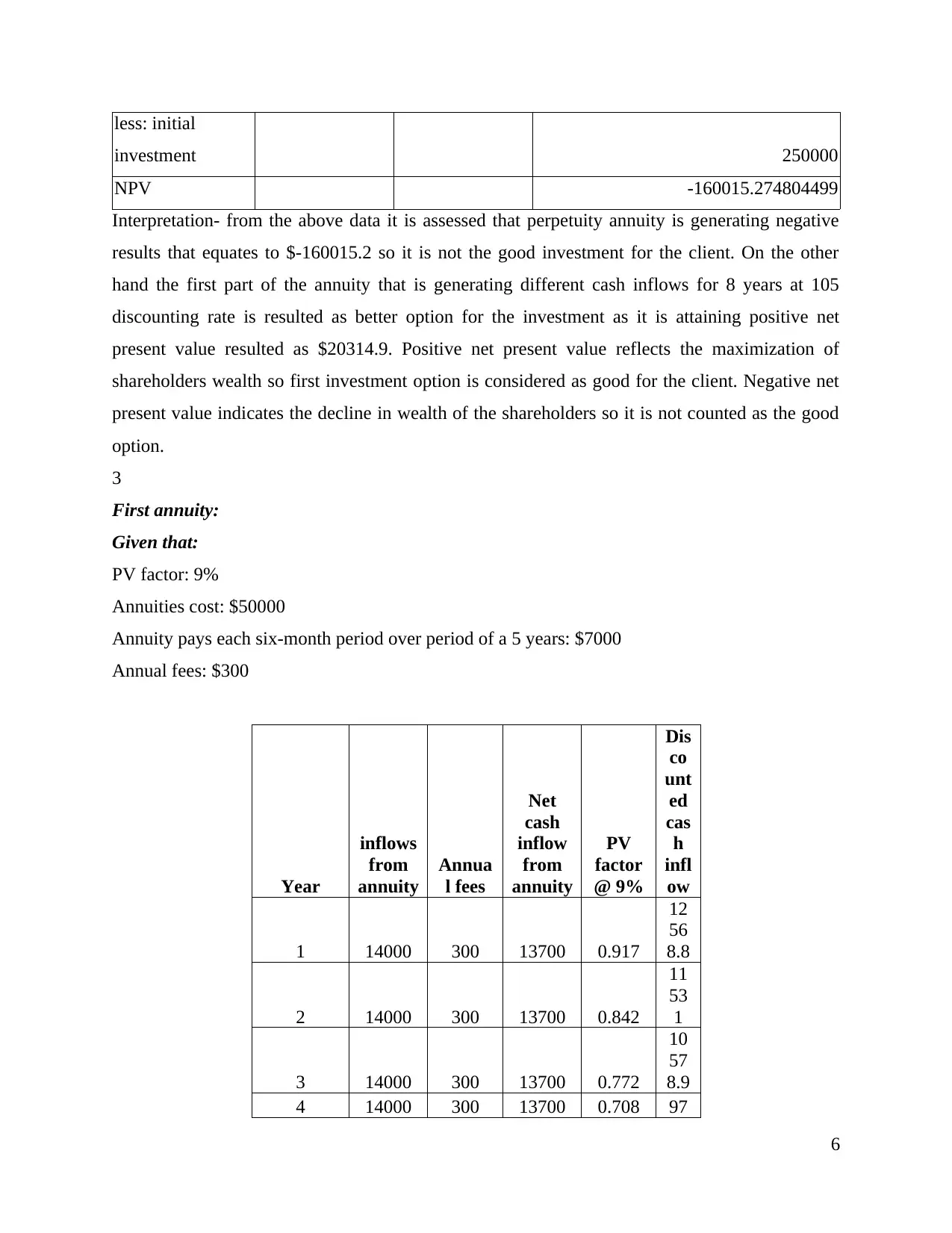
less: initial
investment 250000
NPV -160015.274804499
Interpretation- from the above data it is assessed that perpetuity annuity is generating negative
results that equates to $-160015.2 so it is not the good investment for the client. On the other
hand the first part of the annuity that is generating different cash inflows for 8 years at 105
discounting rate is resulted as better option for the investment as it is attaining positive net
present value resulted as $20314.9. Positive net present value reflects the maximization of
shareholders wealth so first investment option is considered as good for the client. Negative net
present value indicates the decline in wealth of the shareholders so it is not counted as the good
option.
3
First annuity:
Given that:
PV factor: 9%
Annuities cost: $50000
Annuity pays each six-month period over period of a 5 years: $7000
Annual fees: $300
Year
inflows
from
annuity
Annua
l fees
Net
cash
inflow
from
annuity
PV
factor
@ 9%
Dis
co
unt
ed
cas
h
infl
ow
1 14000 300 13700 0.917
12
56
8.8
2 14000 300 13700 0.842
11
53
1
3 14000 300 13700 0.772
10
57
8.9
4 14000 300 13700 0.708 97
6
investment 250000
NPV -160015.274804499
Interpretation- from the above data it is assessed that perpetuity annuity is generating negative
results that equates to $-160015.2 so it is not the good investment for the client. On the other
hand the first part of the annuity that is generating different cash inflows for 8 years at 105
discounting rate is resulted as better option for the investment as it is attaining positive net
present value resulted as $20314.9. Positive net present value reflects the maximization of
shareholders wealth so first investment option is considered as good for the client. Negative net
present value indicates the decline in wealth of the shareholders so it is not counted as the good
option.
3
First annuity:
Given that:
PV factor: 9%
Annuities cost: $50000
Annuity pays each six-month period over period of a 5 years: $7000
Annual fees: $300
Year
inflows
from
annuity
Annua
l fees
Net
cash
inflow
from
annuity
PV
factor
@ 9%
Dis
co
unt
ed
cas
h
infl
ow
1 14000 300 13700 0.917
12
56
8.8
2 14000 300 13700 0.842
11
53
1
3 14000 300 13700 0.772
10
57
8.9
4 14000 300 13700 0.708 97
6

05.
43
5 14000 300 13700 0.650
89
04.
06
Total
discounte
d cash
inflow
53
28
8.2
Less: cost
of annuity
50
00
0
NPV
32
88.
22
Second annuity
Given that:
PV Factor: 10%
Cost of annuity: $50000
annuity pays each month over 5 years: $1000
Year
inflows
from
annuity
Annua
l fees
Net
cash
inflow
from
annuity
PV
factor
@
10%
Dis
co
unt
ed
cas
h
infl
ow
1 12000 0 12000 0.909
10
90
9
2 12000 0 12000 0.826
99
17
3 12000 0 12000 0.751
90
16
4 12000 0 12000 0.683 81
7
43
5 14000 300 13700 0.650
89
04.
06
Total
discounte
d cash
inflow
53
28
8.2
Less: cost
of annuity
50
00
0
NPV
32
88.
22
Second annuity
Given that:
PV Factor: 10%
Cost of annuity: $50000
annuity pays each month over 5 years: $1000
Year
inflows
from
annuity
Annua
l fees
Net
cash
inflow
from
annuity
PV
factor
@
10%
Dis
co
unt
ed
cas
h
infl
ow
1 12000 0 12000 0.909
10
90
9
2 12000 0 12000 0.826
99
17
3 12000 0 12000 0.751
90
16
4 12000 0 12000 0.683 81
7
⊘ This is a preview!⊘
Do you want full access?
Subscribe today to unlock all pages.

Trusted by 1+ million students worldwide
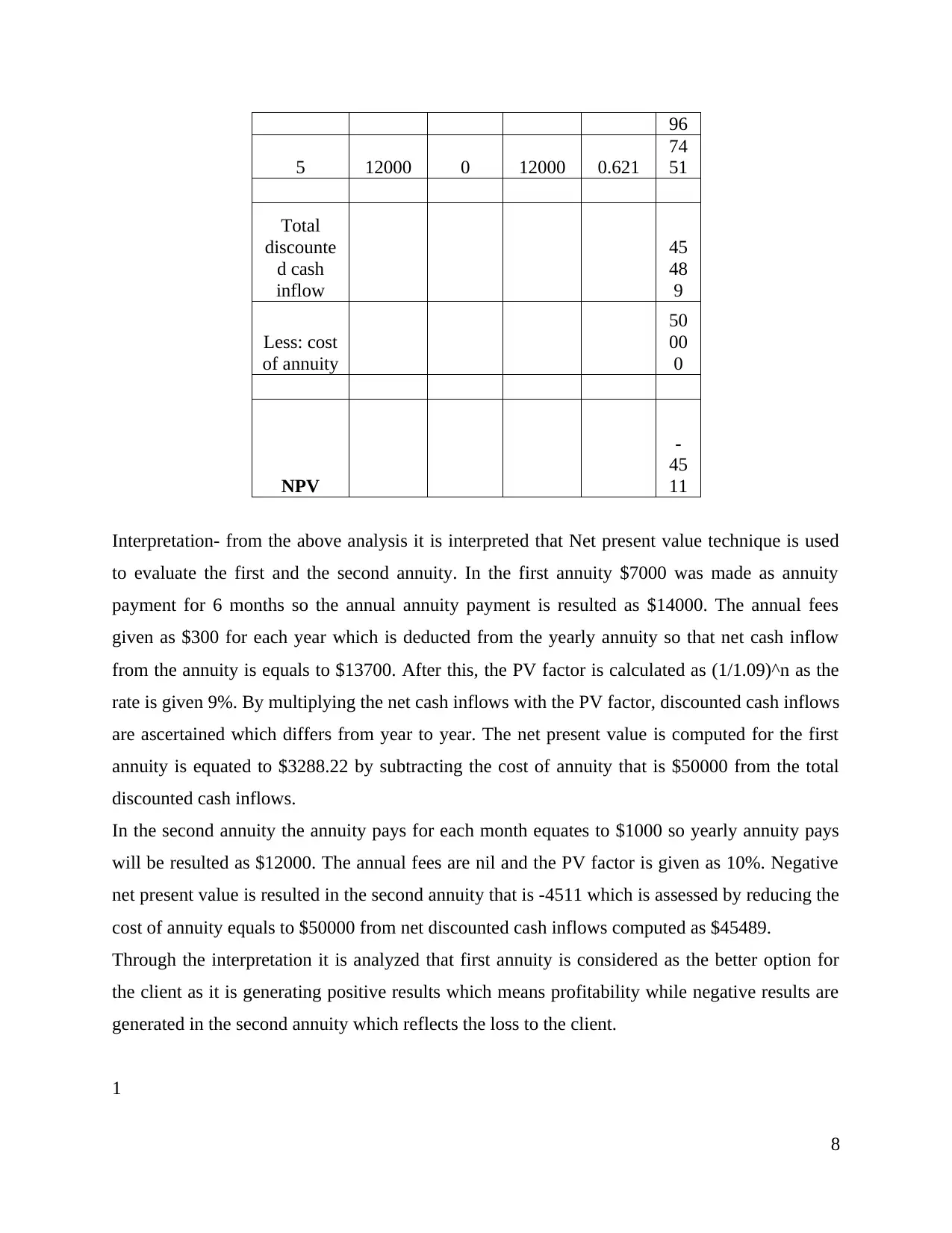
96
5 12000 0 12000 0.621
74
51
Total
discounte
d cash
inflow
45
48
9
Less: cost
of annuity
50
00
0
NPV
-
45
11
Interpretation- from the above analysis it is interpreted that Net present value technique is used
to evaluate the first and the second annuity. In the first annuity $7000 was made as annuity
payment for 6 months so the annual annuity payment is resulted as $14000. The annual fees
given as $300 for each year which is deducted from the yearly annuity so that net cash inflow
from the annuity is equals to $13700. After this, the PV factor is calculated as (1/1.09)^n as the
rate is given 9%. By multiplying the net cash inflows with the PV factor, discounted cash inflows
are ascertained which differs from year to year. The net present value is computed for the first
annuity is equated to $3288.22 by subtracting the cost of annuity that is $50000 from the total
discounted cash inflows.
In the second annuity the annuity pays for each month equates to $1000 so yearly annuity pays
will be resulted as $12000. The annual fees are nil and the PV factor is given as 10%. Negative
net present value is resulted in the second annuity that is -4511 which is assessed by reducing the
cost of annuity equals to $50000 from net discounted cash inflows computed as $45489.
Through the interpretation it is analyzed that first annuity is considered as the better option for
the client as it is generating positive results which means profitability while negative results are
generated in the second annuity which reflects the loss to the client.
1
8
5 12000 0 12000 0.621
74
51
Total
discounte
d cash
inflow
45
48
9
Less: cost
of annuity
50
00
0
NPV
-
45
11
Interpretation- from the above analysis it is interpreted that Net present value technique is used
to evaluate the first and the second annuity. In the first annuity $7000 was made as annuity
payment for 6 months so the annual annuity payment is resulted as $14000. The annual fees
given as $300 for each year which is deducted from the yearly annuity so that net cash inflow
from the annuity is equals to $13700. After this, the PV factor is calculated as (1/1.09)^n as the
rate is given 9%. By multiplying the net cash inflows with the PV factor, discounted cash inflows
are ascertained which differs from year to year. The net present value is computed for the first
annuity is equated to $3288.22 by subtracting the cost of annuity that is $50000 from the total
discounted cash inflows.
In the second annuity the annuity pays for each month equates to $1000 so yearly annuity pays
will be resulted as $12000. The annual fees are nil and the PV factor is given as 10%. Negative
net present value is resulted in the second annuity that is -4511 which is assessed by reducing the
cost of annuity equals to $50000 from net discounted cash inflows computed as $45489.
Through the interpretation it is analyzed that first annuity is considered as the better option for
the client as it is generating positive results which means profitability while negative results are
generated in the second annuity which reflects the loss to the client.
1
8
Paraphrase This Document
Need a fresh take? Get an instant paraphrase of this document with our AI Paraphraser
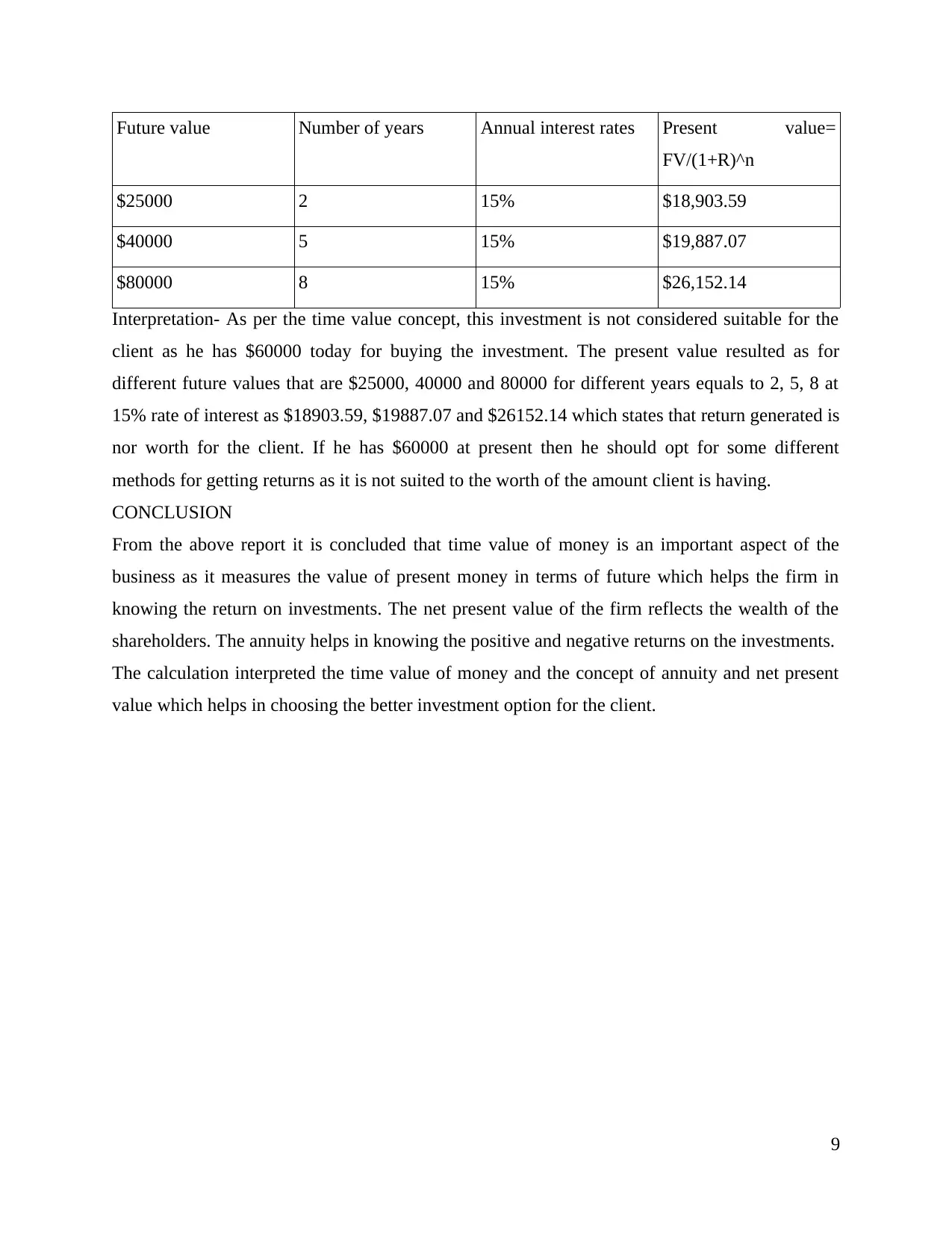
Future value Number of years Annual interest rates Present value=
FV/(1+R)^n
$25000 2 15% $18,903.59
$40000 5 15% $19,887.07
$80000 8 15% $26,152.14
Interpretation- As per the time value concept, this investment is not considered suitable for the
client as he has $60000 today for buying the investment. The present value resulted as for
different future values that are $25000, 40000 and 80000 for different years equals to 2, 5, 8 at
15% rate of interest as $18903.59, $19887.07 and $26152.14 which states that return generated is
nor worth for the client. If he has $60000 at present then he should opt for some different
methods for getting returns as it is not suited to the worth of the amount client is having.
CONCLUSION
From the above report it is concluded that time value of money is an important aspect of the
business as it measures the value of present money in terms of future which helps the firm in
knowing the return on investments. The net present value of the firm reflects the wealth of the
shareholders. The annuity helps in knowing the positive and negative returns on the investments.
The calculation interpreted the time value of money and the concept of annuity and net present
value which helps in choosing the better investment option for the client.
9
FV/(1+R)^n
$25000 2 15% $18,903.59
$40000 5 15% $19,887.07
$80000 8 15% $26,152.14
Interpretation- As per the time value concept, this investment is not considered suitable for the
client as he has $60000 today for buying the investment. The present value resulted as for
different future values that are $25000, 40000 and 80000 for different years equals to 2, 5, 8 at
15% rate of interest as $18903.59, $19887.07 and $26152.14 which states that return generated is
nor worth for the client. If he has $60000 at present then he should opt for some different
methods for getting returns as it is not suited to the worth of the amount client is having.
CONCLUSION
From the above report it is concluded that time value of money is an important aspect of the
business as it measures the value of present money in terms of future which helps the firm in
knowing the return on investments. The net present value of the firm reflects the wealth of the
shareholders. The annuity helps in knowing the positive and negative returns on the investments.
The calculation interpreted the time value of money and the concept of annuity and net present
value which helps in choosing the better investment option for the client.
9
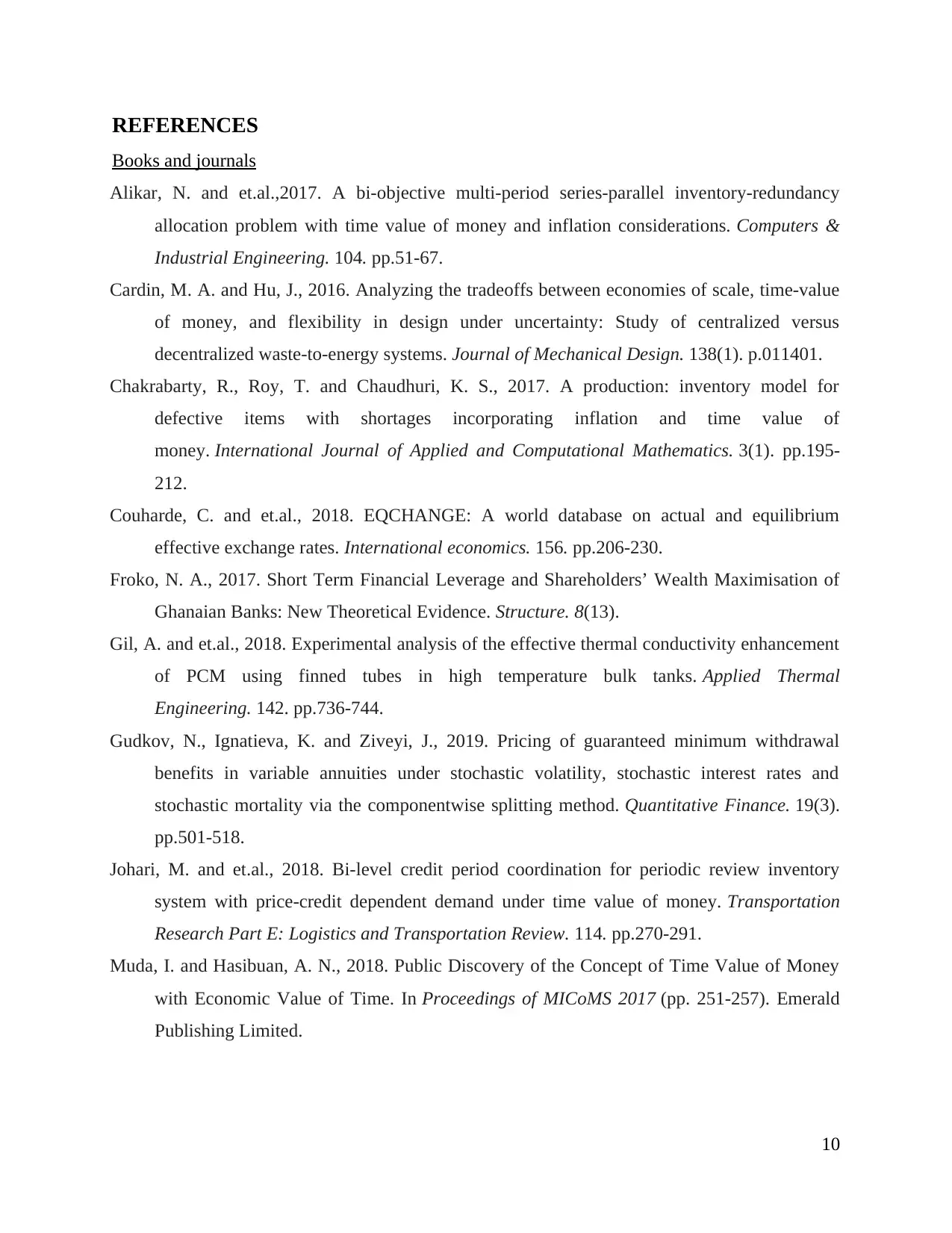
REFERENCES
Books and journals
Alikar, N. and et.al.,2017. A bi-objective multi-period series-parallel inventory-redundancy
allocation problem with time value of money and inflation considerations. Computers &
Industrial Engineering. 104. pp.51-67.
Cardin, M. A. and Hu, J., 2016. Analyzing the tradeoffs between economies of scale, time-value
of money, and flexibility in design under uncertainty: Study of centralized versus
decentralized waste-to-energy systems. Journal of Mechanical Design. 138(1). p.011401.
Chakrabarty, R., Roy, T. and Chaudhuri, K. S., 2017. A production: inventory model for
defective items with shortages incorporating inflation and time value of
money. International Journal of Applied and Computational Mathematics. 3(1). pp.195-
212.
Couharde, C. and et.al., 2018. EQCHANGE: A world database on actual and equilibrium
effective exchange rates. International economics. 156. pp.206-230.
Froko, N. A., 2017. Short Term Financial Leverage and Shareholders’ Wealth Maximisation of
Ghanaian Banks: New Theoretical Evidence. Structure. 8(13).
Gil, A. and et.al., 2018. Experimental analysis of the effective thermal conductivity enhancement
of PCM using finned tubes in high temperature bulk tanks. Applied Thermal
Engineering. 142. pp.736-744.
Gudkov, N., Ignatieva, K. and Ziveyi, J., 2019. Pricing of guaranteed minimum withdrawal
benefits in variable annuities under stochastic volatility, stochastic interest rates and
stochastic mortality via the componentwise splitting method. Quantitative Finance. 19(3).
pp.501-518.
Johari, M. and et.al., 2018. Bi-level credit period coordination for periodic review inventory
system with price-credit dependent demand under time value of money. Transportation
Research Part E: Logistics and Transportation Review. 114. pp.270-291.
Muda, I. and Hasibuan, A. N., 2018. Public Discovery of the Concept of Time Value of Money
with Economic Value of Time. In Proceedings of MICoMS 2017 (pp. 251-257). Emerald
Publishing Limited.
10
Books and journals
Alikar, N. and et.al.,2017. A bi-objective multi-period series-parallel inventory-redundancy
allocation problem with time value of money and inflation considerations. Computers &
Industrial Engineering. 104. pp.51-67.
Cardin, M. A. and Hu, J., 2016. Analyzing the tradeoffs between economies of scale, time-value
of money, and flexibility in design under uncertainty: Study of centralized versus
decentralized waste-to-energy systems. Journal of Mechanical Design. 138(1). p.011401.
Chakrabarty, R., Roy, T. and Chaudhuri, K. S., 2017. A production: inventory model for
defective items with shortages incorporating inflation and time value of
money. International Journal of Applied and Computational Mathematics. 3(1). pp.195-
212.
Couharde, C. and et.al., 2018. EQCHANGE: A world database on actual and equilibrium
effective exchange rates. International economics. 156. pp.206-230.
Froko, N. A., 2017. Short Term Financial Leverage and Shareholders’ Wealth Maximisation of
Ghanaian Banks: New Theoretical Evidence. Structure. 8(13).
Gil, A. and et.al., 2018. Experimental analysis of the effective thermal conductivity enhancement
of PCM using finned tubes in high temperature bulk tanks. Applied Thermal
Engineering. 142. pp.736-744.
Gudkov, N., Ignatieva, K. and Ziveyi, J., 2019. Pricing of guaranteed minimum withdrawal
benefits in variable annuities under stochastic volatility, stochastic interest rates and
stochastic mortality via the componentwise splitting method. Quantitative Finance. 19(3).
pp.501-518.
Johari, M. and et.al., 2018. Bi-level credit period coordination for periodic review inventory
system with price-credit dependent demand under time value of money. Transportation
Research Part E: Logistics and Transportation Review. 114. pp.270-291.
Muda, I. and Hasibuan, A. N., 2018. Public Discovery of the Concept of Time Value of Money
with Economic Value of Time. In Proceedings of MICoMS 2017 (pp. 251-257). Emerald
Publishing Limited.
10
⊘ This is a preview!⊘
Do you want full access?
Subscribe today to unlock all pages.

Trusted by 1+ million students worldwide
1 out of 13
Related Documents
Your All-in-One AI-Powered Toolkit for Academic Success.
+13062052269
info@desklib.com
Available 24*7 on WhatsApp / Email
![[object Object]](/_next/static/media/star-bottom.7253800d.svg)
Unlock your academic potential
Copyright © 2020–2026 A2Z Services. All Rights Reserved. Developed and managed by ZUCOL.





